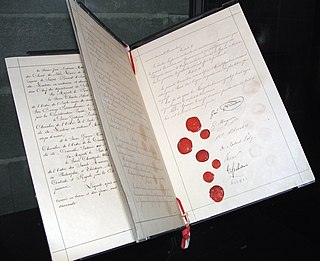
Guerrilla warfare is a form of unconventional warfare in which small groups of irregular military, such as rebels, partisans, paramilitary personnel or armed civilians including recruited children, use ambushes, sabotage, terrorism, raids, petty warfare or hit-and-run tactics in a rebellion, in a violent conflict, in a war or in a civil war to fight against regular military, police or rival insurgent forces.

Terrorism, in its broadest sense, is the use of intentional violence and fear to achieve political or ideological aims. The term is used in this regard primarily to refer to intentional violence during peacetime or in the context of war against non-combatants. The terms "terrorist" and "terrorism" originated during the French Revolution of the late 18th century but became widely used internationally and gained worldwide attention in the 1970s during the Troubles in Northern Ireland, the Basque conflict and the Israeli–Palestinian conflict. The increased use of suicide attacks from the 1980s onwards was typified by the 2001 September 11 attacks in the United States.
Child Soldiers International, formerly the Coalition to Stop the Use of Child Soldiers, was a UK-based non-governmental organization that worked to prevent the recruitment, use and exploitation of children by armed forces and groups. It ceased operations as of 7 June 2019.

Children have been recruited for participation in military operations and campaigns throughout history and in many cultures.
A civilian is a person not a member of an armed force nor a person engaged in hostilities.
Jus ad bellum refers to "the conditions under which States may resort to war or to the use of armed force in general." This is distinct from the set of rules that ought to be followed during a war, known as jus in bello, which govern the behavior of parties in an armed conflict.
There is no universal agreement on the legal definition of terrorism, although there exists a consensus academic definition created by scholars.

An insurgency is a violent, armed rebellion by small, lightly armed bands who practice guerrilla warfare from primarily rural base areas against a larger authority. The key descriptive feature of insurgency is its asymmetric nature: small irregular forces face a large, well-equipped, regular military force state adversary. Due to this asymmetry, insurgents avoid large-scale direct battles, opting instead to blend in with the civilian population where they gradually expand territorial control and military forces. Insurgency frequently hinges on control of and collaboration with local populations.

The Optional Protocol to the Convention on the Rights of the Child on the Involvement of Children in Armed Conflict (OPAC), also known as the child soldier treaty, is a multilateral treaty whereby states agree to: 1) prohibit the conscription into the military of children under the age of 18; 2) ensure that military recruits are no younger than 16; and 3) prevent recruits aged 16 or 17 from taking a direct part in hostilities. The treaty also forbids non-state armed groups from recruiting anyone under the age of 18 for any purpose.
A non-state actor (NSA) An individual or organization that has significant political influence but is not allied to any particular country or state.

On Red Hand Day or the International Day against the Use of Child Soldiers, February 12 each year since 2002, pleas are made to political leaders and events are staged around the world to draw attention to child soldiers: children under the age of 18 who participate in military organizations of all kinds. Red Hand Day aims to call for action to stop this practice, and support children affected by it.

Geneva Call is a non-governmental organization based in Geneva, Switzerland. It is currently focusing its efforts on banning the use of anti-personnel mines, protecting children from the effects of armed conflict, prohibiting sexual violence in armed conflict, working towards the elimination of gender discrimination and building armed non-State actors’ knowledge and implementation of broad International Humanitarian Law (IHL) rules.

Sarah Sewall is Executive Vice President for Policy at In-Q-Tel, a strategic investor for the national security community. A national security expert whose career spans government service and academia, she most recently served as Under Secretary of State for Civilian Security, Democracy, and Human Rights, where she was the key architect of the Obama Administration's preventive approach to combatting violent extremism abroad. At both the Pentagon and State Department, she built and led organizations that integrated security and human rights in their policy and operational work. She spent ten years as a professor at Harvard's Kennedy School of Government, where she directed the Carr Center for Human Rights Policy. In partnership with U.S. military leaders, she helped revise U.S. counterinsurgency doctrine, led groundbreaking field assessments of U.S. civilian casualty mitigation efforts, and created new operational concepts for halting mass atrocities.

The Geneva Conventions are international humanitarian laws consisting of four treaties and three additional protocols that establish international legal standards for humanitarian treatment in war. The singular term Geneva Convention usually denotes the agreements of 1949, negotiated in the aftermath of the Second World War (1939–1945), which updated the terms of the two 1929 treaties and added two new conventions. The Geneva Conventions extensively define the basic rights of wartime prisoners, civilians and military personnel; establish protections for the wounded and sick; and provide protections for the civilians in and around a war-zone.

United Nations Security Council resolution 1493, adopted unanimously on 28 July 2003, after recalling all resolutions on the situation in the Democratic Republic of the Congo, the council extended the mandate of the United Nations Mission in the Democratic Republic of Congo (MONUC) until 30 July 2004 and raised its troop level from 8,700 to 10,800.

Human rights abuse is an ongoing insurgency in Manipur, a northeastern Indian state. The issue started in the 1960s due to a separatist conflict. The Indian army, paramilitary, and police personnel are responsible for killings and torture within Manipur. Human rights violations by Indian security forces are said to have fueled the armed opposition groups in Manipur. Insurgent groups have kidnapped children to train them as child soldiers against the Indian government. Manipur was declared a “disturbed area” by the Indian government in 1980 in the Armed Forces Special Powers Act of 1958.
Military use of schools is a term used to refer to the various activities that national armed forces and non-state armed groups carry out in and around schools, universities, and other education facilities, in support of their military effort. Examples of this include using a school or a university as barracks or bases, for offensive or defensive deployments, for storage of weapons or ammunition, for military training of soldiers, as observation posts, and as a detention facility.

Child soldiers in Africa refers to the military use of children under the age of 18 by national armed forces or other armed groups in Africa. Typically, this classification includes children serving in non-combatant roles, as well as those serving in combatant roles. In 2008, it was estimated that 40 percent of child soldiers worldwide were in Africa, and the use of child soldiers in armed conflict was increasing faster than any other continent. Additionally, average age of children recruited as soldiers appears to be decreasing. As of 2017, the UN listed that seven out of fourteen countries recruiting and using child soldiers in state forces or armed groups were in Africa: Central African Republic, Democratic Republic of the Congo, Mali, Nigeria, Somalia, South Sudan, Sudan.
The terrorist group, self-proclaimed Islamic State (Islamic State of Iraq and Levant also known as Islamic State of Iraq and Syria has committed several fundamental violations of children's rights in the Middle East, particularly in Iraq and Syria The conventions protecting children's rights is the United Nations Convention on the Rights of the Child. This is the most ratified international human rights treaty in history which established the widely supported view that children and young persons have the same basic general human rights as adults and also specific rights that recognize their special needs. A further two additional protocols were adopted by the UN General Assembly on 25 May 2000 covering the involvement of children in armed conflict and on the sale of children, child prostitution and child pornography. In ISIL's rise in the recent years, they have committed various violations of the and its protocols, which have been signed and ratified by Iraq and Syria.

Children in the military are children who are associated with military organizations, such as state armed forces and non-state armed groups. Throughout history and in many cultures, children have been involved in military campaigns. For example, thousands of children participated on all sides of the First World War and the Second World War. Children may be trained and used for combat, assigned to support roles such as porters or messengers, or used for tactical advantage as human shields or for political advantage in propaganda.















